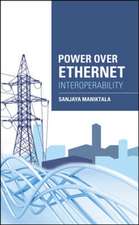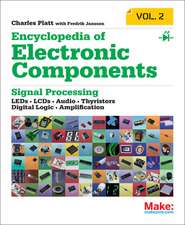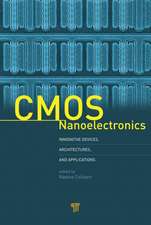Logic Functions and Equations: Binary Models for Computer Science
Autor Christian Posthoff, Bernd Steinbachen Limba Engleză Paperback – 13 dec 2011
Logic Functions and Equationsis highly recommended for a one- or two-semester course in many Computer Science or computer Science-oriented programmes. It allows students an easy high-level access to these methods and enables sophisticated applications in many different areas. It elegantly bridges the gap between Mathematics and the required theoretical foundations of Computer Science.
| Toate formatele și edițiile | Preț | Express |
|---|---|---|
| Paperback (3) | 395.79 lei 3-5 săpt. | +58.30 lei 7-11 zile |
| Springer International Publishing – 8 iun 2023 | 395.79 lei 3-5 săpt. | +58.30 lei 7-11 zile |
| Springer Us – 13 dec 2011 | 465.17 lei 38-44 zile | |
| SPRINGER NETHERLANDS – 19 oct 2010 | 643.50 lei 6-8 săpt. | |
| Hardback (2) | 649.75 lei 6-8 săpt. | |
| SPRINGER NETHERLANDS – 12 feb 2009 | 649.75 lei 6-8 săpt. | |
| Springer International Publishing – 7 iun 2022 | 684.38 lei 6-8 săpt. |
Preț: 465.17 lei
Preț vechi: 581.46 lei
-20% Nou
Puncte Express: 698
Preț estimativ în valută:
89.02€ • 91.96$ • 74.09£
89.02€ • 91.96$ • 74.09£
Carte tipărită la comandă
Livrare economică 21-27 martie
Preluare comenzi: 021 569.72.76
Specificații
ISBN-13: 9781441952615
ISBN-10: 1441952616
Pagini: 424
Dimensiuni: 155 x 235 x 22 mm
Greutate: 0.59 kg
Ediția:Softcover reprint of the original 1st ed. 2004
Editura: Springer Us
Colecția Springer
Locul publicării:New York, NY, United States
ISBN-10: 1441952616
Pagini: 424
Dimensiuni: 155 x 235 x 22 mm
Greutate: 0.59 kg
Ediția:Softcover reprint of the original 1st ed. 2004
Editura: Springer Us
Colecția Springer
Locul publicării:New York, NY, United States
Public țintă
ResearchDescriere
Logic
functions
and
equations
are
(some
of)
the
most
important
concepts
of
Computer
Science
with
many
applications
such
as
Binary
Arithmetics,
Coding,
Complexity,
Logic
Design,
Programming,
Computer
Architecture
and
Artificial
Intelligence.
They
are
very
often
studied
in
a
minimum
way
prior
to
or
together
with
their
respective
applications.
Based
on
our
long-time
teaching
experience,
a
comprehensive
presentation
of
these
concepts
is
given,
especially
emphasising
a
thorough
understanding
as
well
as
numerical
and
computer-based
solution
methods.
Any
applications
and
examples
from
all
the
respective
areas
are
given
that
can
be
dealt
with
in
a
unified
way.
They
offer
a
broad
understanding
of
the
recent
developments
in
Computer
Science
and
are
directly
applicable
in
professional
life.
Logic Functions and Equationsis highly recommended for a one- or two-semester course in many Computer Science or computer Science-oriented programmes. It allows students an easy high-level access to these methods and enables sophisticated applications in many different areas. It elegantly bridges the gap between Mathematics and the required theoretical foundations of Computer Science.
Logic Functions and Equationsis highly recommended for a one- or two-semester course in many Computer Science or computer Science-oriented programmes. It allows students an easy high-level access to these methods and enables sophisticated applications in many different areas. It elegantly bridges the gap between Mathematics and the required theoretical foundations of Computer Science.
Cuprins
I.
Theoretical
Foundations.-
1.
Basic
Algebraic
Structures.-
2.
Logic
Functions.-
4.
Boolean
Differential
Calculus.-
5.
The
Solution
of
Logic
Equations.-
II.
Applications.-
6.
Logics
and
Arithmetics.-
7.
Combinational
Circuits.-
8.
Finite-State
Machines.-
III.
Tools.-
9.
Xboole.
Recenzii
From
the
reviews
of
the
first
edition:
"The book under analysis has two main features which distinguish it from the numerous other books devoted to the applications of the two-element Boolean algebra to computer science and related fields. The first characteristic is the manner in which the beginner is introduced to the field. The authors adopt a strongly conversational style. … The other main feature of this book is the crucial role played by the authors’ own research on Boolean differential calculus … ." (Sergiu Rudeanu, Zentralblatt MATH, Vol. 1087, 2006)
"The book under analysis has two main features which distinguish it from the numerous other books devoted to the applications of the two-element Boolean algebra to computer science and related fields. The first characteristic is the manner in which the beginner is introduced to the field. The authors adopt a strongly conversational style. … The other main feature of this book is the crucial role played by the authors’ own research on Boolean differential calculus … ." (Sergiu Rudeanu, Zentralblatt MATH, Vol. 1087, 2006)
Caracteristici
Highly
recommended
for
a
one-
or
two-semester
course
in
many
Computer
Science
or
Computer
Science-oriented
programmes
Allows students an easy high-level access to the methods
Enables sophisticated applications in many different areas
Elegantly bridges the gap between Mathematics and the required theoretical foundations of Computer Science
Allows students an easy high-level access to the methods
Enables sophisticated applications in many different areas
Elegantly bridges the gap between Mathematics and the required theoretical foundations of Computer Science
Notă biografică
Bernd Steinbach studied Information Technology at the University of Technology in Chemnitz (Germany) and graduated with an M.Sc. in 1973. He graduated with a Ph.D. and with a Dr. sc. techn. (Doctor scientiae technicarum) for his second doctoral thesis from the Faculty of Electrical Engineering of the Chemnitz University of Technology in 1981 and 1984, respectively. In 1991 he obtained the Habilitation (Dr.-Ing. habil.) from the same Faculty. Topics of his theses involved Boolean equations, Boolean differential equations, and their application in the field of circuit design using efficient algorithms and data structures on computers.
He was working in industry as an Electrician, there he tested professional controlling systems at the Niles Company. After finishing his studies, he taught as Assistant Lecturer at the Department of Information Technology of the Chemnitz University of Technology. In a following period of industrial occupation as a research engineer he developed programs for test pattern generation for computer circuits at the company ROBOTRON. Thereafter he returned to the Department of Information Technology of the Chemnitz University of Technology as Associate Professor for design automation in logic design.
From 1992 to 2017 he was a Full Professor of Computer Science / Software Engineering and Programming at the Freiberg University of Mining and Technology, Department of Computer Science. He served as Head of the Department of Computer Science and Vice-Dean of the Faculty of Mathematics and Computer Science. His research areas include logic functions and equations and their application in many fields, such as Artificial Intelligence, UML - based testing of software, UML - based hardware / software co-design, and extremely complex problems. He is the head of a group that developed the XBOOLE software system. He is co-author and editor of 19 books. He published more than 280 chapters in books, complete issuesof journals, and papers in journals and proceedings.
He has served as Program Chairman for the IEEE International Symposium on Multiple-Valued Logic (ISMVL), and as guest editor of the Journal of Multiple-Valued Logic and Soft Computing. He is the initiator and was the general chair of the first 12 workshops of a biennial series of International Workshops on Boolean Problems (IWSBP), which started in 1994. He received the Barkhausen Award from the University of Technology Dresden in 1983.
Christian Posthoff studied Mathematics at the University of Leipzig. From 1968 to 1972, he worked as a programmer and in the field of Operations Research; simultaneously, he did his Ph.D. in 1975 with the thesis "Application of Mathematical Methods in Communicative Psychotherapy". In 1972, he began working at the Department of Information Technology at the Chemnitz University of Technology; up to 1983, his research activities concentrated on logic design. Important results have been algorithms and programs for solving Boolean equations with a high number of variables and the Boolean Differential Calculus (a generalized differential and integral calculus for Boolean rings) for the analytical treatment of different problems in the field of logic design. These results have been collected in a monograph "Binary Dynamic Systems", and allowed the habilitation (Dr.-Ing. habil.) at the Faculty of Electrical Engineering in 1979 and the promotion to Associate Professor. In 1983, he was promoted to Full Professor of Computer Science in the Department of Computer Science at the same university, and since 1984, he was Head of the Institute of Theoretical Computer Science and Artificial Intelligence and Research Director of the Department of Computer Science. His research activities included the application of fuzzy logics for the modeling of human-like "thinking" methods, learning from examples, the construction of intelligent tutoring systems, the parallelization of inference mechanisms, systems of diagnosis and configuration. He received the Scientific Award of the Chemnitz University of Technology four times.
In 1994, he moved to the Chair of Computer Science at The University of The West Indies, St. Augustine, Trinidad & Tobago. From 1996 to 2002 he was Head of the Department of Mathematics & Computer Science. He mainly focused on the development of Computer Science education at the undergraduate and graduate levels to attain international standard. Twenty years later it can be said that these intentions were very successfully fulfilled. In 2001, he received the Vice-Chancellor's Award of Excellence. From 2010 – 2012 he spent two years at St. Georges University in Grenada with the same goals. Since his return to Germany (now retired) he devoted his efforts to the interdisciplinary research and education in several areas (ComputerScience – Mathematics – Applications in different fields). He is the author or co-author of more than 25 books and many publications in journals and conference proceedings.
He was working in industry as an Electrician, there he tested professional controlling systems at the Niles Company. After finishing his studies, he taught as Assistant Lecturer at the Department of Information Technology of the Chemnitz University of Technology. In a following period of industrial occupation as a research engineer he developed programs for test pattern generation for computer circuits at the company ROBOTRON. Thereafter he returned to the Department of Information Technology of the Chemnitz University of Technology as Associate Professor for design automation in logic design.
From 1992 to 2017 he was a Full Professor of Computer Science / Software Engineering and Programming at the Freiberg University of Mining and Technology, Department of Computer Science. He served as Head of the Department of Computer Science and Vice-Dean of the Faculty of Mathematics and Computer Science. His research areas include logic functions and equations and their application in many fields, such as Artificial Intelligence, UML - based testing of software, UML - based hardware / software co-design, and extremely complex problems. He is the head of a group that developed the XBOOLE software system. He is co-author and editor of 19 books. He published more than 280 chapters in books, complete issuesof journals, and papers in journals and proceedings.
He has served as Program Chairman for the IEEE International Symposium on Multiple-Valued Logic (ISMVL), and as guest editor of the Journal of Multiple-Valued Logic and Soft Computing. He is the initiator and was the general chair of the first 12 workshops of a biennial series of International Workshops on Boolean Problems (IWSBP), which started in 1994. He received the Barkhausen Award from the University of Technology Dresden in 1983.
Christian Posthoff studied Mathematics at the University of Leipzig. From 1968 to 1972, he worked as a programmer and in the field of Operations Research; simultaneously, he did his Ph.D. in 1975 with the thesis "Application of Mathematical Methods in Communicative Psychotherapy". In 1972, he began working at the Department of Information Technology at the Chemnitz University of Technology; up to 1983, his research activities concentrated on logic design. Important results have been algorithms and programs for solving Boolean equations with a high number of variables and the Boolean Differential Calculus (a generalized differential and integral calculus for Boolean rings) for the analytical treatment of different problems in the field of logic design. These results have been collected in a monograph "Binary Dynamic Systems", and allowed the habilitation (Dr.-Ing. habil.) at the Faculty of Electrical Engineering in 1979 and the promotion to Associate Professor. In 1983, he was promoted to Full Professor of Computer Science in the Department of Computer Science at the same university, and since 1984, he was Head of the Institute of Theoretical Computer Science and Artificial Intelligence and Research Director of the Department of Computer Science. His research activities included the application of fuzzy logics for the modeling of human-like "thinking" methods, learning from examples, the construction of intelligent tutoring systems, the parallelization of inference mechanisms, systems of diagnosis and configuration. He received the Scientific Award of the Chemnitz University of Technology four times.
In 1994, he moved to the Chair of Computer Science at The University of The West Indies, St. Augustine, Trinidad & Tobago. From 1996 to 2002 he was Head of the Department of Mathematics & Computer Science. He mainly focused on the development of Computer Science education at the undergraduate and graduate levels to attain international standard. Twenty years later it can be said that these intentions were very successfully fulfilled. In 2001, he received the Vice-Chancellor's Award of Excellence. From 2010 – 2012 he spent two years at St. Georges University in Grenada with the same goals. Since his return to Germany (now retired) he devoted his efforts to the interdisciplinary research and education in several areas (ComputerScience – Mathematics – Applications in different fields). He is the author or co-author of more than 25 books and many publications in journals and conference proceedings.
Textul de pe ultima copertă
The greatly expanded and updated 3rd edition of this textbook offers the reader a comprehensive introduction to the concepts of logic functions and equations and their applications across computer science and engineering. The authors’ approach emphasizes a thorough understanding of the fundamental principles as well as numerical and computer-based solution methods. The book provides insight into applications across propositional logic, binary arithmetic, coding, cryptography, complexity, logic design, and artificial intelligence.
Updated throughout, some major additions for the 3rd edition include:
Updated throughout, some major additions for the 3rd edition include:
- a new chapter about the concepts contributing to the power of XBOOLE;
- a new chapter that introduces into the application of the XBOOLE-Monitor XBM 2;
- many tasks that support the readers in amplifying the learned content at the end of the chapters;
- solutions of a large subset of these tasks to confirm learning success;
- challenging tasks that need the power of the XBOOLE software for their solution.
















